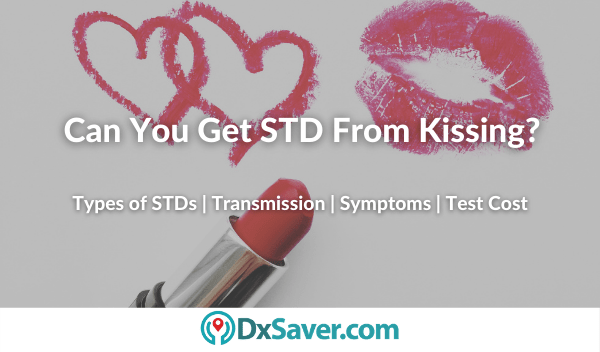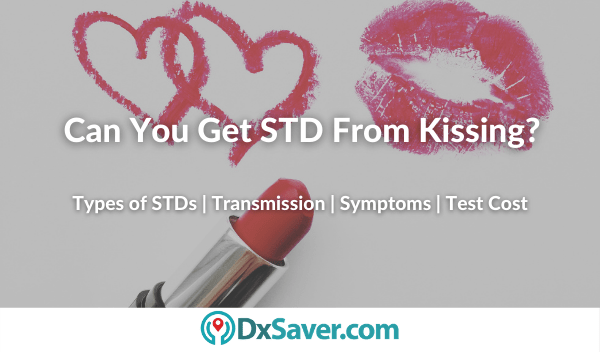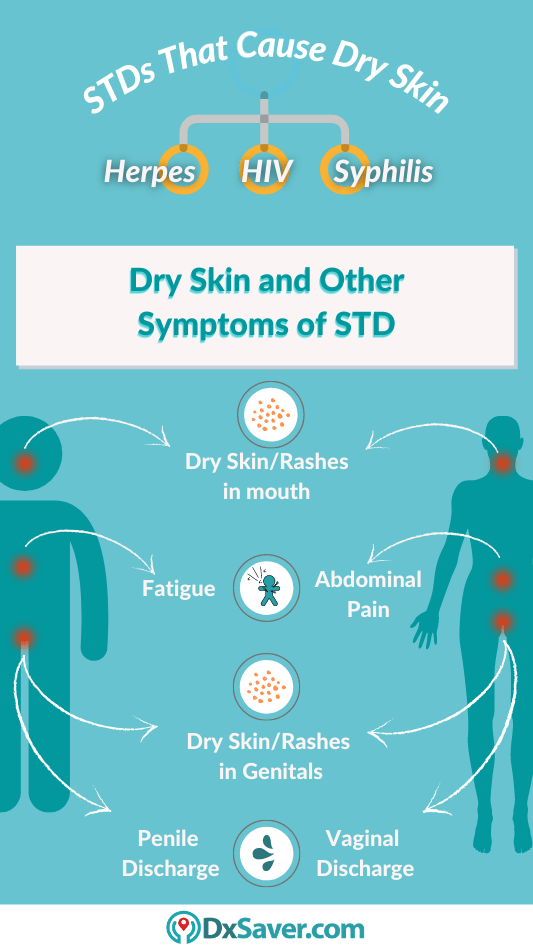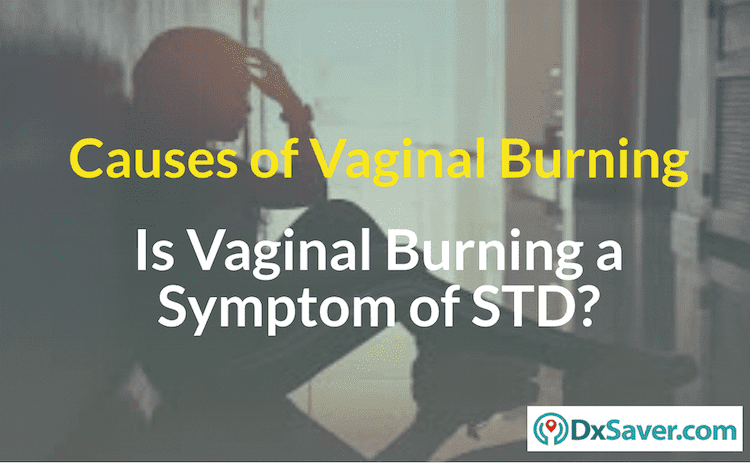Sexually Transmitted Diseases (STDs) are infections that transmit only via sexual contact or the exchange of blood products from an infected person. However, there are certain STDs that have the potential to spread without sexual contact, just via skin-skin contact, mainly through kissing.
In this article, we explain in detail the STDs that spread via kissing, STD symptoms, treatment, and testing cost.
- Can you get STD from Kissing?
- When can STD Symptoms Appear?
- What are the Types of STDs?
- How are STDs Transmitted?
- STD Symptoms in Men and Women
- How are STDs Treated?
- How to Get Checked for STDs?
- Is there a Home Test Kit Available for STDs?
- STD Testing Cost in the US
- Providers Location
Can you get STD from Kissing?
Some microorganisms that cause STDs are transferable between individuals by kissing. Following are the 3 types of STDs that can be transmitted through kissing –
- Herpes (HSV)
- Syphilis
- Mononucleosis
Generally, STDs do not show any symptoms until 2 – 4 weeks after the initial exposure. Your partner may not know that he/she is affected by an STD. Thus spreading it to others unknowingly accounts for the widespread cases of STDs across the US.
STD from Kissing: Herpes
Herpes is a viral infection caused by Herpes Simplex Virus (HSV). Herpes STD is categorized into two different types, based on the infection site. Herpes Simplex Virus type 1 (HSV-1) is associated with cold sores and mouth lesions. HSV-1 is termed Oral Herpes. On the other hand, Herpes Simplex Virus type 2 (HSV-2) generally infected the genital area, HSA-2 is also known as Genital Herpes. Both strains are extremely contagious and have no complete cure.
According to the World Health Organisation (WHO), there are more than 3.7 billion people under age 50 around the world affected with Oral Herpes. Oral herpes is the type that spreads through kissing. Symptoms of oral herpes include blisters in your mouth (clear, pink, red, yellow, or gray in color), sore throat, and pain while eating or swallowing.
STD from Kissing: Syphilis
Syphilis is a bacterial infection that is treatable in its initial stage. Syphilis STD has been on the rise since the year 2005. Syphilis STD progresses in three phases namely – primary stage, secondary stage, and final stage. During the first stage, symptoms occur as sores around the mouth, called chancres. They may also be seen around the genital area. Even though the sores are minute – sometimes undetectable in the early stage, the syphilis bacteria will likely be around the sores, causing infection to others who come into contact.
Other symptoms of Syphilis include headache, fever, skin rash, joint pain, hair loss, and weight loss.
STD from Kissing: Mononucleosis
Mononucleosis or Monospot disease is caused by Espin-bar-virus (EBV). Monospot disease is also commonly known as the “kissing disease” as the virus is easily transmitted via kissing. If you suspect having mono disease, don’t kiss anyone or share things like drinking glasses, eating utensils, or toothbrushes.
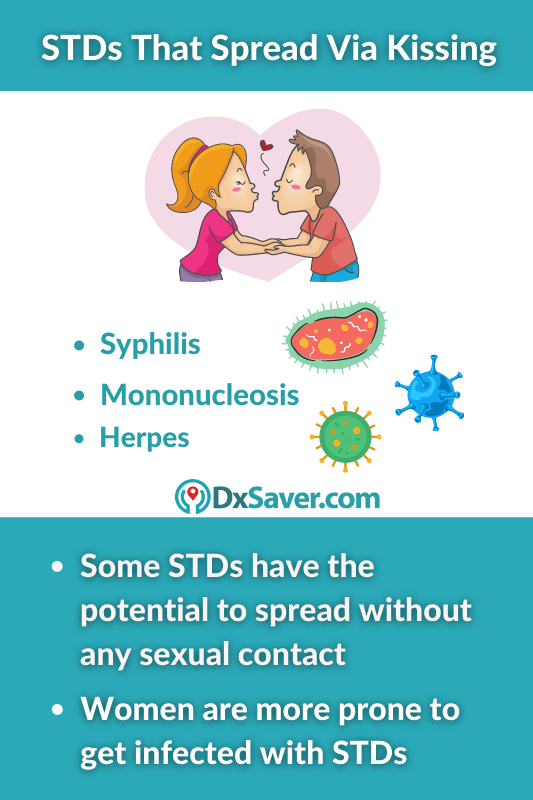
When can STD Symptoms Appear?
STD symptoms may appear anytime between 10 to 90 days after the initial exposure from unprotected sex. It is also worth mentioning that, most people do not experience any symptoms for several weeks and tend to spread the infection unknowingly to other sex partners. This is one of the prime reasons for wide-spread cases of STDs across the US, especially among the youth, where most of the STD cases are reported under the age group of 15 – 24.
Thus is it vital for everyone who is sexually active to get screened for STDs at least once every 6 months to be on the safer side.
What are the Other Types of STDs?
There are more than 30 different types of STDs that are caused by different types of microorganisms like viruses, parasites, bacteria, and fungi. However, only 8 types are most commonly reported. They are –
- Chlamydia
- Gonorrhea
- Syphilis
- Herpes
- Trichomoniasis
- HIV
- HPV
- Hepatitis
Other than Syphilis, Herpes, and Mono disease, the rest of the STDs are very much unlikely to transmit via kissing. Most of the time the infections occur during sexual contact.
How are STDs Transmitted?
STDs are the most contagious diseases and are generally transmitted during vaginal, oral, or anal sex. They can also spread through blood contact and skin contact with the infected person. Rarely, there are chances of getting some STDs when you come into close contact with moist objects like towels, wet clothing, or toilet seats. A pregnant woman having any sexually transmitted infection can pass it to her child at birth.
STD Symptoms in Men and Women
STD symptoms do not exhibit immediately after the initial exposure to the virus or the bacteria. Some STDs show up symptoms within 2 – 4 weeks after the exposure, other STDs like HIV tend to play in silence, not exhibiting any symptoms for several months, if not years, and keeps multiplying and destroying the immune system. Some of the common symptoms of STDs include –
- Fever
- Headache
- Weight loss
- Diarrhea
- Joint pain
- Jaundice
- Sore throat
- Dry cough
- Night sweat
- Fatigue
STD Symptoms in Women
- Unusual vaginal discharge
- Painful urination
- Pain during sexual intercourse
- Lower abdominal pain
- Heavy menstrual bleeding
STD Symptoms in Men
- Thick penile discharge
- Burning sensation while urinating
- Swollen testicles
- Anal itching
- Irritation inside the penis
- Painful bowel movements
How are STDs treated?
Bacterial STDs can be treated with antibiotics if treatment begins at an early stage. Unfortunately, viral STDs are not cured, but you can control symptoms by daily medications. If you are given antibiotics to treat STD, you should take all of the drugs prescribed by your physician, even though you stop showing symptoms. Also, avoid taking someone else’s medication to cure your infection; this will lead to severe difficulties to diagnose.
How to get tested for STDs?
There are different forms of tests to get diagnosed with STDs. Firstly, your physician may ask you to take any of the following tests like using a cotton swab in the infected area such as mouth, throat, vagina, anus, or penis or may be asked to take a blood sample or a urine sample. The test shall be taken based on the medical and sexual history you have and the symptoms you experience.
Is there an STD home test kit available?
There are STD home test kits available to get tested at home. You can order an STD test kit online from one of our testing providers. Order your STD home test kit now! All you need to do is follow the instructions mentioned on the testing kit and post it back. STD home test kit requires a simple oral swab collection and an easy finger-prick blood spot collection and the results will be mailed to you within 2 to 5 business days.
It is mostly preferred by the people who have those who do not have time from their everyday schedule, taking an appointment, and visiting the testing lab. Also, those who are not convenient in having an awkward conversation to answer questions about their sexual history with a medical physician in the lab can prefer a home testing kit.
How much is the cost of the STD test?
There are many options available for the STD home test kit, but we have identified the best and the most affordable home test kit providers and have listed them out for our readers. One of our STD testing providers who are CLIA – Certified is located across the U.S., offers an at-home STD test kit at an affordable price.
The following table shows the STD home test kit and STD testing cost at 3 of our partner laboratories (CLIA – Certified) network located across the U.S.
Name of our Partner Labs | Book Online |
STD Check Labs
| Starting from
|
LetsGetChecked(Home Test Kit)
| Starting from
$74.25 |
HealthLabs
| Starting from$24 |
Providers location
STD tests can be done in any of the following states either at the provider’s location or home. To know the STD testing cost, check the above table.
- Alabama
- Arizona
- Arkansas
- California
- Colorado
- Connecticut
- Delaware
- Florida
- Hawaii
- Georgia
- Idaho
- Illinois
- Indiana
- Iowa
- Kansas
- Kentucky
- Louisiana
- Maine
- Michigan
- Minnesota
- Mississippi
- Missouri
- Montana
- Nebraska
- Nevada
- New Hampshire
- New Mexico
- North Carolina
- North Dakota
- Oklahoma
- Oregon
- Pennsylvania
- Puerto Rico
- South Carolina
- South Dakota
- Tennessee
- Texas
- Utah
- Vermont
- Virginia
- Washington
- West Virginia
- Wisconsin
- Wyoming
Frequently Asked Questions
Will insurance cover my STD testing cost?
No. Generally providers do not accept the insurance in order to ensure your privacy. However, they will provide you a receipt for insurance reimbursement purposes.
How should I book my appointment for STD testing?
You can choose the most suitable provider from above and make an appointment by following the instructions mentioned by them.
Can I cancel my lab test order?
Yes, you can cancel your lab test order anytime before your testing. A refund will be initiated after deducting the cancellation fee. However, cancellation is at the discretion of the provider.
Do the providers offer result interpretations?
Yes, few providers may provide doctor consultation who will take you through the results and provide clarification if needed.
How do I receive my report?
In order to ensure your privacy, the test report will be mailed to you by the provider.
Other topics you may be interested in –
- MCH Blood Test Cost in the US
- Eye Chlamydia Symptoms
- Stages of Lung Cancer
- Lipase Testing Cost in the US
- At-home HIV Testing Cost
- Urine Culture Test and UTI Infection Symptoms
- Importance of H Pylori Bacterium and GI Infections
- Symptoms and Diagnosis of Hepatitis B
- STD Testing Cost in Colorado
- At-home Chlamydia Test Cost
- Causes of Vaginal Burning Sensation
- Importance of BNP Blood Test and Normal Levels
- HCT in Blood Test – Detail
- Uric Acid Blood Test Cost in the US
- Types of STDs That Cause Mouth Sores Symptoms in Men and Women
